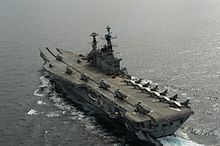INS Viraat (R22)
|
||||||||||||||||||
|
||||||||||||||||||
|
||||||||||||||||||
|
||||||||||||||||||
The INS Viraat (R22) , formerly HMS Hermes , is a British Centaur- class aircraft carrier that was in active service with the Indian Navy from 1989 to 2016 . Before that, he was employed as Hermes in the Royal Navy from 1959 to 1982 and was used during the Falklands War , among other things .
history
The ship was commissioned in 1943 as the fourth aircraft carrier of the Centaur class, originally designed for eight units, and was laid down in 1944 at the Vickers-Armstrong shipyard in Barrow-in-Furness . Originally it was supposed to be named HMS Elephant . After the war ended in 1945, construction of the ship was stopped and only continued in 1952. After the decision was made not to finish the other four Centaur carriers, the Elephant was given the traditional name Hermes . This was originally intended for one of the no longer completed units. After the Hermes was launched in 1953, it took another six years before it could be commissioned as the flagship of the British Pacific fleet in 1959. In 1971 it was converted into a command ship of the Royal Navy . Shortly afterwards the launch catapults were removed and replaced by a ski jump , a kind of ski jump, in order to test the use of vertical take-offs on aircraft carriers. After the successful completion of the tests, the construction of a successor ship, the Invincible, began .
In 1981 the Royal Navy decided to retire the Hermes . With the outbreak of the Falklands War, however, these plans were suspended, and the aircraft carrier was dispatched to the South Atlantic together with the recently completed Invincible . There the ship proved its efficiency and made a considerable contribution to the recapture of the British crown colony. Two years later, however, it was decommissioned. In 1985 the scrapping of the ship began.
In 1985, India submitted an offer to the Royal Navy and scrapping, which had already been initiated, was halted. In 1986 the ship was transferred to India and refurbished. A year later she was put back into service on May 12, 1987 under the name Viraat . After several incidents during the first test drives, including a fire in the engine room, the Viraat was towed back to the dock, where it remained until 1994. With the retirement of the second Indian aircraft carrier Vikrant , also a former British aircraft carrier, the Viraat returned to active service. From 1999 to 2000 another major life-extension measure took place in which, among other things, the drive, the sensors, the weapon systems and the communication systems were fundamentally overhauled and renewed. Since then, the ship has been in permanent use, with the exception of a short stay in the shipyard in 2006, and has participated in several maneuvers with the Royal Navy. Despite the recently good condition, a replacement for the now over 50-year-old ship was inevitable, also because only a few of the Sea Harrier carrier fighter aircraft were still airworthy. This had already earned the Viraat the nickname One Harrier Carrier .
Plans to buy the British HMS Invincible were abandoned and the Invincible was scrapped in Turkey . Instead, India signed the purchase agreement for the Russian aircraft carrier Admiral Gorshkov in 2004 . However, because the renovation of the Admiral Gorschkow was repeatedly delayed, the decision was made to subject the Viraat to a new life extension program in order to be able to extend their service life into 2020. The ship was overhauled in Mumbai by August 2009 . Above all, the drive system was repaired and renewed. In addition, work was carried out on the weapon systems and the air conditioning. After the work was completed, further repairs under the waterline were carried out in Kochi . In November 2013 the Admiral Gorschkow was completely renewed as INS Vikramaditya . Because the Indian Navy now had a second functioning aircraft carrier, the overhaul of the Viraat scheduled for 2014 was canceled and the ship was announced to be decommissioned in 2016.
From February 4th to 8th, 2016 the Viraat took part in the 11th International Fleet Review of the Indian Navy, which took place off Visakhapatnam on the east coast of India and in which ships and boats of 24 navies took part. On February 10, 2016, the Viraat returned to Mumbai and was taken out of active service there. The Viraat was also formally retired in July 2016 and is then to be cannibalized. There are plans to convert the ship into a hotel and turn it into a tourist attraction in the state of Andhra Pradesh . Of the 30 Harriers procured for Viraat , six are currently still in an airworthy condition. In future, they will be used for training purposes at Dabolim Airport .
The Viraat was most recently the largest active STOVL aircraft carrier and the oldest aircraft carrier still in active service in the world.
See also
Web links
Individual evidence
- ↑ INS Viraat to be decommissioned in 2016
- ↑ The six decade journey of INS Viraat ends this week , Indian Express, July 22, 2016
- ↑ India is decommissioning the world's oldest aircraft carrier
- ↑ Indian carrier Viraat 'de-operationalized'
- ↑ INS Viraat: A warship that will soon be converted into a hotel!

